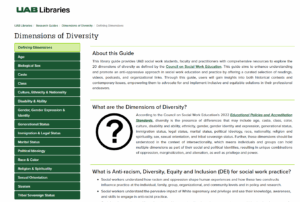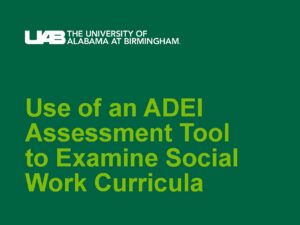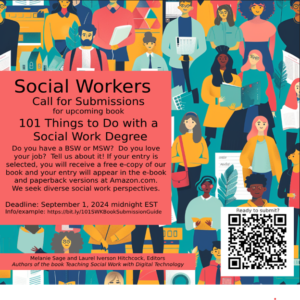The Social Work Dimensions of Diversity Library Guide
One of my favorite parts of teaching social work is watching students discover the connections between theory and practice, especially those moments when social justice moves from abstract ideas to meaningful frameworks for understanding the world. Finding the right learning resources, such as a book, movie or podcast, to facilitate those discoveries hasn’t always been easy.
Like many of you, I’ve spent countless hours searching for materials that do more than just acknowledge diversity. I wanted resources that helped students understand how systems of power and privilege actually shape people’s lives, materials that centered the voices of those most affected by oppression. I also realized that if I, as a full-time educator, was spending a lot of time finding these resources, our adjunct faculty might be struggling too. Given that the Council on Social Work Education’s 2022 Educational Policies and Accreditation Standards (CSWE, 2022) now embeds requirements for diversity and equity content throughout social work curricula, I wanted to find a way to curate and share resources.

This idea led to an exciting collaboration with Dana Hettich, a reference librarian at the University of Alabama at Birmingham (UAB) Libraries. Together with help from Lana Turner, MSW Student and soon-to-be UAB alumnus, we developed the Social Work Dimensions of Diversity Library Guide, a project that has become more than just a teaching resource. It’s evolved into a living, collaborative space where students, faculty, and librarians work together to build something meaningful.
Call for Contributions: Help Us Expand the Community-Engaged Learning Toolkit
My colleagues, Drs. Nathalie Jones, Melanie Sage, and I are excited to invite submissions for an expanded edition of the Professionalism for Community-Engaged Learning Student Workbook and a new Educator’s Guide. This expanded resource will enhance teaching and learning by offering structured assignments, reflective activities, and instructional strategies that prepare students for professionalism in community-based learning.
About the Project
The Professionalism for Community-Engaged Learning Student Workbook is part of the Professionalism for Community-Engaged Learning Toolkit. This Toolkit provides resources and learning activities emphasizing the practical skills and knowledge necessary for novice student learners to thrive in community-engaged learning projects (such as volunteering and service learning) in higher education.
Drawing from Social Work Education and applicable to other fields, this workbook is designed to assist student learners in developing the knowledge and skills essential for a professional demeanor during community-engaged learning projects, concentrating on behavior, appearance, and communication in oral, written, and electronic formats. The workbook includes three sections:
Use of an ADEI Assessment Tool to Examine Social Work Curricula
On October 25, 2024, during the Annual Program Meeting for the Council on Social Work Education in Kansas City, MO, my UAB colleagues (Colleen Fisher, Mary Jacque Carroll and Ron Pitner) and I presented an assessment tool developed by Melissa Freedman, MSW, to review syllabi and courses as an effort to ensure the integration of antiracism, diversity, equity, and inclusion (ADEI) within our program curricula at the University of Alabama at Birmingham’s Department of Social Work. We used this tool to assess course content in our Bachelor’s, Master’s and Field Education courses. In this blog post, we provide access to the tool and slides from the presentation.
Call for Submissions: 101 Things to Do with a Social Work Degree
My colleague, Dr. Melanie Sage and I are excited to invite submissions for our upcoming book, tentatively called 101 Things to Do with a Social Work Degree. This book aims to showcase social workers’ diverse and impactful roles across various settings. We seek contributions in English from social workers actively practicing or utilizing their social work degrees in traditional or unique settings at the micro, mezzo, and macro levels.
Ideal Contributors:
We are looking for social workers who:





